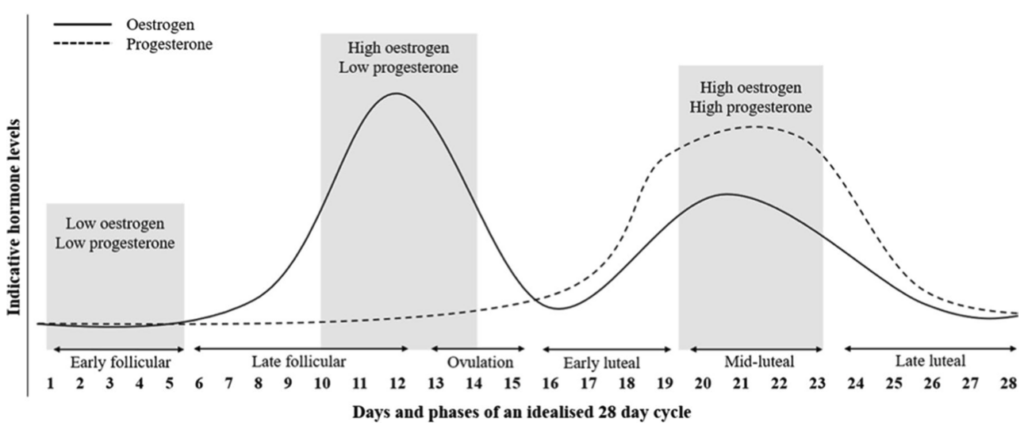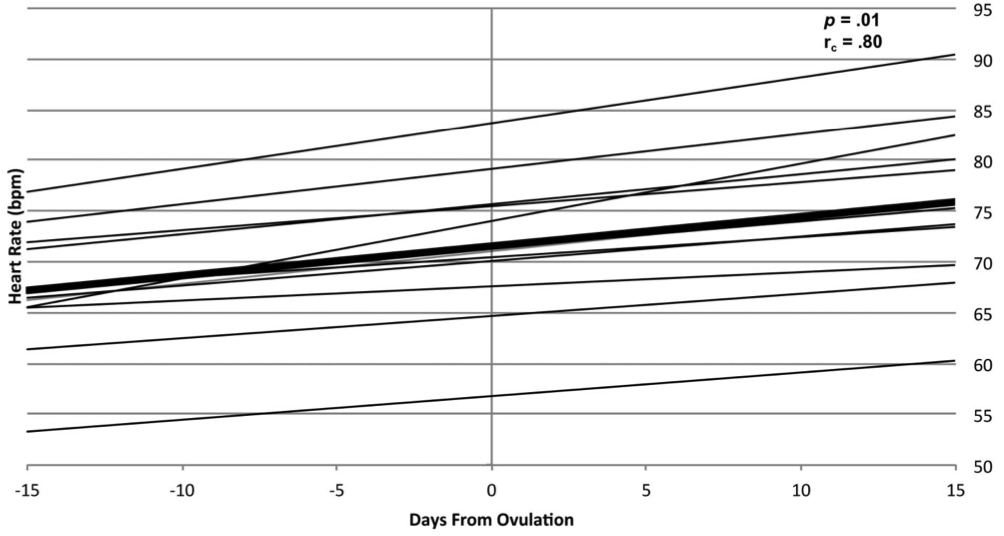In addition to the challenge of balancing training time and recovery, female athletes have the additional challenge of managing their performance throughout their menstrual cycle. Hormone levels, particularly estrogen (or oestrogen) and progesterone vary widely across the 28-day cycle. Here’s how these variations affect both performance and recovery.
Shifting Estrogen and Progesterone Levels
There is a range of mechanisms through which varying hormone levels might affect exercise performance. In particular, estrogen has been shown to have an anabolic (building) effect on skeletal muscle and might enhance muscle fuel storage and fat-burning capability. However, progesterone is considered to have the opposite effect compared to estrogen.
Looking across the 28-day cycle (although this number can vary person-to-person), we might expect performance and recovery to be higher during times when estrogen is high, and progesterone is low, i.e., the late follicular phase. Conversely, we might expect performance to be lower during the early follicular phase when estrogen levels are low.

Menstrual Cycle and Sporting Performance
Historically, there has been little consensus on whether exercise performance is affected by the menstrual cycle. In 2020, a group of researchers from the UK and Brazil set out to perform a comprehensive review of eligible studies addressing the exercise performance of 1200 women. These candidates were between the ages of 18 and 40, had normal periods and were not taking oral contraceptives. Despite there being a substantial number of study results considered (78), the conclusions were not consistent between them, with many of the studies being marked as low quality (although they all appeared in peer-reviewed journals). The authors did manage to conclude two things, though:
- There was a small but consistent reduction in sports and exercise performance during the early follicular phase.
- Variation between individual athletes was high, necessitating an individual approach to optimizing training loads across the menstrual cycle.

Heart Rate Variability (HRV) and the Menstrual Cycle
So, if an individual approach is warranted, how might we monitor that? Heart Rate Variability (HRV) is a recognized biomarker reflecting the relative contributions of the sympathetic (fight or flight) and parasympathetic (rest and digest) branches of the autonomic nervous system. The menstrual cycle and associated hormones have been suggested to contribute to relatively higher levels of parasympathetic HRV seen in women (often despite higher resting heart rates).
A 2014 study performed by the University of Texas’s Department of Kinesiology together with the US Army Human Research Laboratory investigated the effect of the menstrual cycle on HRV in healthy young women. Values were assessed five times over the course of the subjects’ menstrual cycles. Their findings were consistent across the 13 subjects. The chart below shows the all-inclusive SDNN measure of HRV for each participant (as well as the mean in bold). Additionally, the results they had for high-frequency (parasympathetic) and low-frequency (parasympathetic + sympathetic) measures were all consistent with this pattern of HRV decreasing across the menstrual cycle, to which the researchers attributed parasympathetic withdrawal:

This was also consistent with a rise in resting heart rate (HR), which they observed in parallel:

A 2015 study performed with 50 young women in India also found all time-domain HRV measures (including RMSSD, the parameter used by Training Peaks partner ithlete) were higher in the phase before ovulation than after, during the secretory phase.
The implications for athletic performance from these studies were not clear, though, as there was no exercise component (intervention) involved.
A 2019 study involving seven young female Canadian cyclists also found decreased HRV between four and 11 days after ovulation. Interestingly, they attributed this reduction to the effects of progesterone, which has been linked to increases in heart rate, body temperature, breathing rate, and at higher concentrations to increased levels of adrenaline – the fight or flight hormone.
Summarizing the Findings
In spite of there being several research studies looking at both HRV and exercise performance, the conclusions are not as clear as we would like, however, there are some general takeaways worth remembering:
- Higher levels of estrogen pre-ovulation are thought to have positive effects on exercise recovery by facilitating muscle rebuilding, muscle fuel storage and increased fat utilization. Oestrogen is also considered to be cardioprotective – i.e., it helps maintain the health of the heart and blood vessels.
- Higher levels of progesterone about seven days post-ovulation may have positive effects on performance due to raised adrenaline levels.
- Exercise performance may be reduced by a small amount in the early follicular phase immediately following the period when the production of both estrogen and progesterone are at a low level.
HRV software can provide you with tools to flag dates relevant to the menstrual cycle, and to allow you to differentiate between days when you feel energized versus days when you feel tired and need extra recovery. Building up a pattern over a few months will help you get to know your body, and what it’s capable of better. Athletes can track their HRV with ithlete with an exclusive extended free trial for Training Peaks users. As for coaches, you monitor their progress and help visualize trends in the FREE ithlete Coach App.
References:
McNulty, K.L., Elliott-Sale, K.J., Dolan, E. et al. The Effects of Menstrual Cycle Phase on Exercise Performance in Eumenorrheic Women: A Systematic Review and Meta-Analysis. Sports Med 50, 1813–1827 (2020).
Kokts-Porietis, R. L., Minichiello, N. R., & Doyle-Baker, P. K. (2019, May 7). The Effect of the Menstrual Cycle on Daily Measures of Heart Rate Variability in Athletic Women. Journal of Psychophysiology
Matthew S. Tenan, R. Matthew Brothers, Andrew J. Tweedell, Anthony C. Hackney, Lisa Griffin. Changes in resting heart rate variability across the menstrual cycle. Journal of Psychophysiology
Brar, T.K., Singh, K.D., Kumar, A. (2015). Effect of Different Phases of Menstrual Cycle on Heart Rate Variability (HRV), Journal of Clinical and Diagnostic Research








